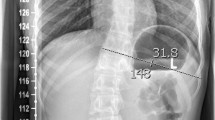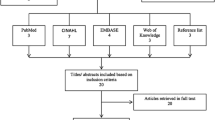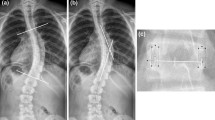Abstract
Background
Scoliosis of the vertebral column can be assessed with the Cobb angle (Cobb 1948). This examination is performed manually by measuring the angle on radiographs and is considered the gold standard. However, studies evaluating the reproducibility of this procedure have shown high variability in intra- and inter-observer agreement. Because of technical advancements, interests in new procedures to determine the Cobb angle has been renewed. This review aims to systematically investigate the reproducibility of various new techniques to determine the Cobb angle in idiopathic scoliosis and to assess whether new technical procedures are reasonable alternatives when compared to manual measurement of the Cobb angle.
Method
Systematic review. Studies examining procedures used to determine the Cobb angle were selected. Two review authors independently selected studies for inclusion, extracted data and assessed risk of bias. Statistical results of reliability and agreement were summarised and described.
Results
Eleven studies of new measuring procedures were included, all reporting the reproducibility. The new procedures can be divided into computer-assisted procedures, automatic procedures and smartphone apps.
Conclusions
All investigated measuring procedures showed high degrees of reliability. In general, digital procedures tend to be slightly better than manual ones. For all other measurement procedures (automatic or smartphone), results varied. Studies implementing vertebral pre-selection and observer training achieved better agreement.



Similar content being viewed by others
Abbreviations
- D2L, D4L, D6L:
-
Digital two, four or six landmarks
- DH:
-
Digital horizontal
- A:
-
Automatic
- S:
-
Smartphone
- ICC:
-
Intraclass Correlation
- R:
-
Correlation Coefficient
- QUADAS:
-
Quality Assessment of Diagnostic Accuracy Studies
- QAREL:
-
Quality Appraisal of Reliability Studies
- NA:
-
Not assessed
- SD:
-
Standard Deviation
- SEM:
-
Standard Error of Measurement
- MAD:
-
Mean Absolute Difference
- CI:
-
Confidence Interval
References
Cobb JR (1948) Outline for the study of scoliosis. Am Acad Orthop Surg Instr Course Lect 5:261–275
Romano M, Minozzi S, Bettany-Saltikov J, Zaina F, Chockalingam N, Kotwicki T, Maier-Hennes A, Negrini S (2012) Exercises for adolescent idiopathic scoliosis. Cochrane Database Syst Rev 8:CD007837. doi:10.1002/14651858.CD007837.pub2
Negrini S, Minozzi S, Bettany-Saltikov J, Zaina F, Chockalingam N, Grivas TB, Kotwicki T, Maruyama T, Romano M, Vasiliadis ES (2010) Braces for idiopathic scoliosis in adolescents. Spine (Phila Pa 1976) 35(13):1285–1293. doi:10.1097/BRS.0b013e3181dc48f4
Morrissy RT, Goldsmith GS, Hall EC, Kehl D, Cowie GH (1990) Measurement of the Cobb angle on radiographs of patients who have scoliosis. Evaluation of intrinsic error. J Bone Joint Surg Am 72(3):320–327
Carman DL, Browne RH, Birch JG (1990) Measurement of scoliosis and kyphosis radiographs. Intraobserver and interobserver variation. J Bone Joint Surg Am 72(3):328–333
Srinivasalu S, Modi HN, Smehta S, Suh SW, Chen T, Murun T (2008) Cobb angle measurement of scoliosis using computer measurement of digitally acquired radiographs-intraobserver and interobserver variability. Asian Spine J 2(2):90–93. doi:10.4184/asj.2008.2.2.90
Corona J, Sanders JO, Luhmann SJ, Diab M, Vitale MG (2012) Reliability of radiographic measures for infantile idiopathic scoliosis. J Bone Joint Surg Am 94(12):e861–e868. doi:10.2106/JBJS.K.00311
Jones JK, Krow A, Hariharan S, Weekes L (2008) Measuring angles on digitalized radiographic images using Microsoft PowerPoint. West Indian Med J 57(1):14–19
Tanure MC, Pinheiro AP, Oliveira AS (2010) Reliability assessment of Cobb angle measurements using manual and digital methods. Spine J 10(9):769–774. doi:10.1016/j.spinee.2010.02.020
Shea KG, Stevens PM, Nelson M, Smith JT, Masters KS, Yandow S (1998) A comparison of manual versus computer-assisted radiographic measurement. Intraobserver measurement variability for Cobb angles. Spine (Phila Pa 1976) 23(5):551–555
Cheung J, Wever DJ, Veldhuizen AG, Klein JP, Verdonck B, Nijlunsing R, Cool JC, Van Horn JR (2002) The reliability of quantitative analysis on digital images of the scoliotic spine. Eur Spine J 11(6):535–542. doi:10.1007/s00586-001-0381-7
Chockalingam N, Dangerfield PH, Giakas G, Cochrane T, Dorgan JC (2002) Computer-assisted Cobb measurement of scoliosis. Eur Spine J 11(4):353–357. doi:10.1007/s00586-002-0386-x
Allen S, Parent E, Khorasani M, Hill DL, Lou E, Raso JV (2008) Validity and reliability of active shape models for the estimation of cobb angle in patients with adolescent idiopathic scoliosis. J Digit Imaging 21(2):208–218. doi:10.1007/s10278-007-9026-7
Zhang J, Lou E, Hill DL, Raso JV, Wang Y, Le LH, Shi X (2010) Computer-aided assessment of scoliosis on posteroanterior radiographs. Med Biol Eng Comput 48(2):185–195. doi:10.1007/s11517-009-0556-7
Shaw M, Adam CJ, Izatt MT, Licina P, Askin GN (2012) Use of the iPhone for Cobb angle measurement in scoliosis. Eur Spine J 21(6):1062–1068. doi:10.1007/s00586-011-2059-0
Qiao J, Liu Z, Xu L, Wu T, Zheng X, Zhu Z, Zhu F, Qian B, Qiu Y (2012) Reliability analysis of a smartphone-aided measurement method for the Cobb angle of scoliosis. J Spinal Disord Tech 25(4):E88–E92. doi:10.1097/BSD.0b013e3182463964
de Vet HC, Terwee CB, Knol DL, Bouter LM (2006) When to use agreement versus reliability measures. J Clin Epidemiol 59(10):1033–1039. doi:10.1016/j.jclinepi.2005.10.015
Bartlett JW, Frost C (2008) Reliability, repeatability and reproducibility: analysis of measurement errors in continuous variables. Ultrasound Obstet Gynecol 31(4):466–475. doi:10.1002/uog.5256
Shrout PE, Fleiss JL (1979) Intraclass correlations: uses in assessing rater reliability. Psychol Bull 86(2):420–428
Streiner DL, Norman GR (2008) Health measurement scales a practical guide to their development and use, vol 4. Oxford University Press, Oxford
Whiting P, Rutjes AW, Dinnes J, Reitsma J, Bossuyt PM, Kleijnen J (2004) Development and validation of methods for assessing the quality of diagnostic accuracy studies. Health Technol Assess 8(25):1–234 (pii: 98-27-99)
Lucas NP, Macaskill P, Irwig L, Bogduk N (2010) The development of a quality appraisal tool for studies of diagnostic reliability (QAREL). J Clin Epidemiol 63(8):854–861. doi:10.1016/j.jclinepi.2009.10.002
Zhang J, Lou E, Le LH, Hill DL, Raso JV, Wang Y (2009) Automatic Cobb measurement of scoliosis based on fuzzy Hough transform with vertebral shape prior. J Digit Imaging 22(5):463–472. doi:10.1007/s10278-008-9127-y
Zhang J, Lou E, Shi X, Wang Y, Hill DL, Raso JV, Le LH, Lv L (2010) A computer-aided Cobb angle measurement method and its reliability. J Spinal Disord Tech 23(6):383–387. doi:10.1097/BSD.0b013e3181bb9a3c
Goldberg MS, Poitras B, Mayo NE, Labelle H, Bourassa R, Cloutier R (1988) Observer variation in assessing spinal curvature and skeletal development in adolescent idiopathic scoliosis. Spine (Phila Pa 1976) 13(12):1371–1377
Lonstein JE, Carlson JM (1984) The prediction of curve progression in untreated idiopathic scoliosis during growth. J Bone Joint Surg Am 66(7):1061–1071
Pruijs JE, Hageman MA, Keessen W, van der Meer R, van Wieringen JC (1994) Variation in Cobb angle measurements in scoliosis. Skeletal Radiol 23(7):517–520
Bland JM, Altman DG (1986) Statistical methods for assessing agreement between two methods of clinical measurement. Lancet 1(8476):307–310
Conflict of interest
None.
Author information
Authors and Affiliations
Corresponding author
Rights and permissions
About this article
Cite this article
Langensiepen, S., Semler, O., Sobottke, R. et al. Measuring procedures to determine the Cobb angle in idiopathic scoliosis: a systematic review. Eur Spine J 22, 2360–2371 (2013). https://doi.org/10.1007/s00586-013-2693-9
Received:
Revised:
Accepted:
Published:
Issue Date:
DOI: https://doi.org/10.1007/s00586-013-2693-9




